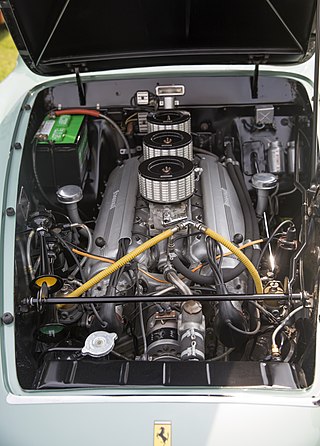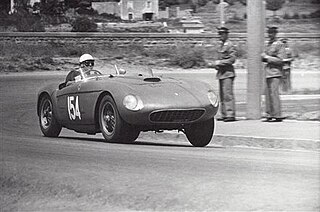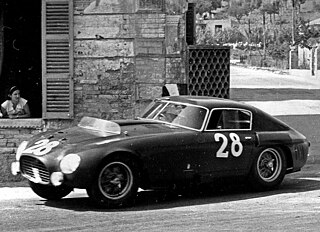
The Ferrari Lampredi engine was a naturally aspirated all aluminum 60° V12 engine produced between 1950 and 1959. Inline-4 and Inline-6 variants for racing were derived from it.

Carrozzeria Scaglietti was an Italian automobile design and coachbuilding company active in the 1950s. It was founded by Sergio Scaglietti in 1951 as an automobile repair concern, but was located across the road from Ferrari in Maranello outside Modena, Italy.

The Ferrari 166 S was a sports racing car built by Ferrari between 1948 and 1953, as a evolution of its Colombo V12-powered 125 S racer. It was adapted into a sports car for the street in the form of the 166 Inter.

The Ferrari 250 is a series of sports cars and grand tourers built by Ferrari from 1952 to 1964. The company's most successful early line, the 250 series includes many variants designed for road use or sports car racing. 250 series cars are characterized by their use of a 3.0 L (2,953 cc) Colombo V12 engine designed by Gioacchino Colombo. The 250 series designation refers to this engine's cylinder displacement of approximately 250 cc. They were replaced by the 275 and 330 series cars.

The Ferrari 195 S was a sports racing car produced by Ferrari in 1950, as a improved version of the 166 MM. The 195 S won Mille Miglia, Coppa della Toscana and Giro delle Calabria.

The Ferrari 225 S was a sports racing car produced by Ferrari in 1952. It was an evolution over the preceding Ferrari 212 Export with important engine upgrades that greatly improved power output. The model was extensively used in competition, winning many international races. The most important include 1952 Monaco Grand Prix for sports cars, Portuguese Grand Prix, Coppa d'Oro di Sicilia, Coppa della Toscana, Coppa d'Oro delle Dolomiti and many others. It was the final Colombo V12 engine iteration before the 250-family stretched it to 3.0-litres capacity.

The Ferrari Monza is one of a series of cars built by Ferrari. In the early 1950s, Ferrari shifted from using the compact Gioacchino Colombo-designed V12 engine in its smallest class of sports racers to a line of four-cylinder engines designed by Aurelio Lampredi. Inspired by the success of the light and reliable 2.5 L 553 F1 car, the four-cylinder sports racers competed successfully through the late 1950s, culminating with the famed 500 Mondial and 750 Monza.

The Ferrari 212 Export was a sports racing car produced by Ferrari in 1951–1952. The 212 Exports won Tour de France automobile, Giro di Sicilia, Coppa della Toscana, 10 Hours of Messina and other motor races throughout its career. It was meant to be a sports car available for oversea markets.

The Ferrari 375 Plus is a sports racing car produced by Ferrari in 1954. The model competed internationally, winning many major races, including 24 Hours of Le Mans, Carrera Panamericana, 1000km of Buenos Aires, Agadir GP and Silverstone.

The Ferrari 250 Monza was a sports racing car produced by Ferrari in 1954. It was a combination of a stretched chassis and body from the line of inline-four-engined racers with an ubiquitous 3.0-litre Colombo V12 engine.

The Ferrari 315 S is a sports racing car produced by Ferrari in 1957. The model served as the replacement of the Ferrari 290 MM, which had won the 1956 Mille Miglia and was an effort to dethrone the ever powerful Maserati 450S.

The Ferrari 290 MM is a sports racing car produced by the Italian automobile manufacturer Ferrari in 1956. It was developed to compete in the 1956 edition of Mille Miglia as a successor to the 860 Monza, hence the acronym "MM", and four cars were built.

The Ferrari 335 S was a sports racing car produced by Italian automobile manufacturer Ferrari between 1957 and 1958. The car was a direct response to the Maserati 450S which with its 4.5-litre engine was threatening to overpower the 3.8-litre 315 S and 3.5-litre 290 MM. Four cars were produced in total.

The Ferrari 375 MM, was a sports racing car produced by Ferrari from 1953 to 1955. It was named "375" for the unitary displacement of one cylinder in the 4.5 L V12 engine, and the "MM" stood for the Mille Miglia race. In total 26 units were made, including four converted from the 340 MM.

Vittorio Jano designed a new 60° V12 engine for sports car racing for Ferrari. This new engine, introduced in 1956, combined elements of both Colombo and Lampredi engines with new features. Engine architecture was more of Lampredi school but retained smaller Colombo internal measurements. Jano moved to Ferrari along with his designs for the Lancia D50 in 1955 and went on to design not only a new V12 but also a family of the Dino V6 engines soon after. Some of the technical ideas came from the Jano's Lancia V8 DOHC engine, intended for Formula One. This family of engines replaced Lampredi inline-4s known from Ferrari Monza line and went on to win many international races and titles for Ferrari. The design team comprised Jano as well as Vittorio Bellentani, Alberto Massimino, and Andrea Fraschetti.

The Ferrari 275 S was a sports racing car produced by Ferrari in 1950. It was the first Ferrari powered by a new Aurelio Lampredi-designed V12 engine, created as a large displacement alternative to the initial 1,5 L Colombo V12, used in supercharged form in Ferrari 125 F1. Formula One regulations allowed for up to 4.5 L in naturally aspirated form.

The Ferrari 250 MM was a sports racing car produced by Ferrari from 1952 to 1954. After the initial racing successes of the 3.0-litre Colombo V12 engine, introduced in the 250 S one-off, Ferrari produced a serial racing model. It is best recognisable for the distinctive closed berlinetta bodywork by Pinin Farina. The "MM" in its name stood for the Mille Miglia race.

The Ferrari 376 S was a sports racing car produced by Ferrari in 1955. It was the first raced Ferrari powered by a new Aurelio Lampredi-designed inline-6 engine, created as a larger alternative to the inline-4 series of engines used in the Ferrari Monza race cars. The intention behind the development of this model was the 1955 Mille Miglia race. It was yet another attempt by Ferrari to match the new Mercedes-Benz 300 SLR in competition. All of the created cars were further converted into a bigger capacity models.

The Ferrari 290 S was a sports racing car produced by Ferrari in 1957. It was a development of an earlier 290 MM race car that won the 1956 Mille Miglia. The 290 S was the first sports car manufactured by Ferrari to be powered by a DOHC V12 engine. Its career was very short but it served as an important milestone in the Jano V12-powered lineage.

The Ferrari 412 S was a unique sports racing car produced by Ferrari in 1958. The 412 S combined Ferrari's most powerful V12 engine to date with a one-off experimental racing chassis. It was also incorrectly called as the 412 MI due to being built around an engine from the 500 Miles of Monza racer. The car was created specifically for John von Neumann to take on the American racing cars Scarabs in SCCA racing. Its famed drivers included Phil Hill and Richie Ginther.
























